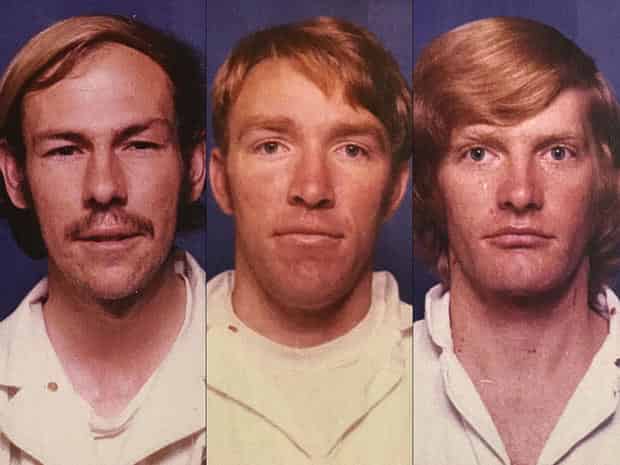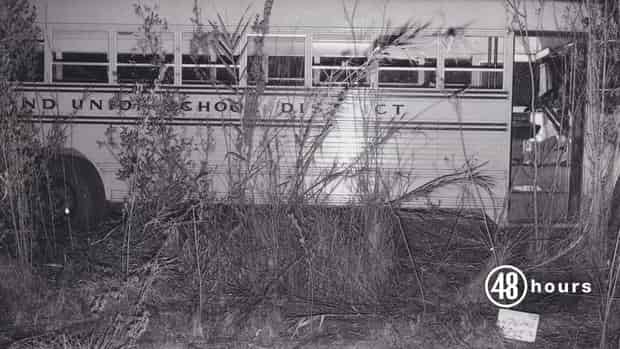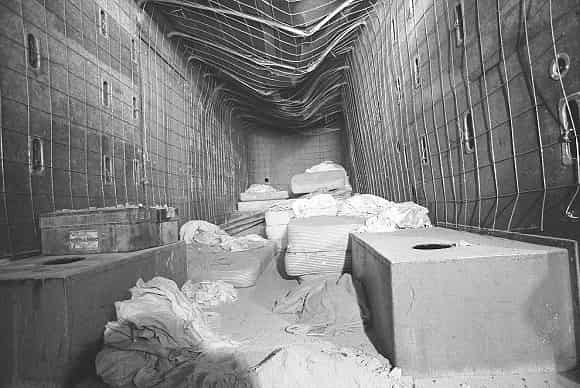The 1976 Chowchilla Bus Kidnapping: A Crime That Shook America

In 1976, a shocking crime shook the small town of Chowchilla, California. Three young men from wealthy Bay Area families—Frederick Woods and brothers James and Richard Schoenfeld—came up with a terrifying plan to make quick money. Although they were rich, greed and desperation drove them to commit one of the most infamous kidnappings in U.S. history.
The men decided to target children, believing this would force authorities to pay a large ransom. “We needed multiple victims to get multiple millions,” they reasoned. Their plan was to demand millions of dollars, convinced the state would do anything to protect innocent lives.
The Kidnapping
On July 15, 1976, a school bus carrying 26 children from Dairyland Elementary School was heading home. The children, aged 5 to 14, were enjoying their summer day when the bus was suddenly stopped on a quiet road by the kidnappers. The men, wearing crude masks, held guns and ordered everyone off the bus.
The bus driver, Frank Edward “Ed” Ray, tried to protect the children but was overpowered. The kidnappers forced Ed and the children into two vans that had been specially modified to keep them from escaping. The vans were dark, hot, and soundproof, making the experience even more terrifying for the children.
The Underground Prison
After hours of driving, the kidnappers took their victims to a rock quarry in Livermore, California. There, they forced Ed and the children into an underground bunker that they had prepared in advance. This bunker was a buried truck trailer, reinforced to keep the victims trapped.

The kidnappers sealed the bunker with a heavy metal door and placed 200-pound batteries on top to ensure no one could escape. Inside, the children and Ed were left with minimal food, water, and ventilation. The conditions were cramped and horrifying, with little light and a growing sense of fear.

A Failed Ransom Plan
The kidnappers planned to demand $5 million in ransom (equivalent to nearly $28 million today). However, their plan quickly ran into problems. When they tried to call the police to deliver their ransom demand, they found the phone lines were jammed. Frustrated and tired, the kidnappers decided to rest and call again later.
While they were sleeping, the children and Ed were already working on a daring escape.
A Heroic Escape
Inside the bunker, Ed Ray and the older children took charge. Despite the fear and exhaustion, they encouraged everyone to stay calm and work together. After 16 terrifying hours, they managed to push open the heavy hatch blocking their escape. The group climbed out of the underground prison and walked to safety.
When news broke of their escape, it quickly became a national sensation. People were amazed at the bravery of Ed Ray and the children, who had managed to survive and free themselves from such a horrifying situation.
Justice is Served
The three kidnappers, Frederick Woods and the Schoenfeld brothers, were quickly identified and arrested. Their wealthy backgrounds and the careful planning behind the crime shocked the public. All three men were sentenced to life in prison without parole. However, over the years, they became eligible for parole due to changes in the law.
James Schoenfeld was released in 2015, Richard Schoenfeld in 2012, and Frederick Woods in 2022. Despite their release, their actions left a lasting scar on the victims and their families.
Honoring a Hero
Frank Edward “Ed” Ray, the bus driver who protected the children and helped them escape, was hailed as a hero. He remained a beloved figure in Chowchilla for the rest of his life. In 2015, the town renamed a local park in his honor and declared February 26 as “Edward Ray Day” to celebrate his bravery and dedication.
The Legacy of the Chowchilla Kidnapping
The 1976 Chowchilla bus kidnapping remains one of the most disturbing crimes in American history. It was a chilling reminder of how greed and desperation can lead to unimaginable actions. Yet, it also became a story of courage, teamwork, and survival.
The children, now adults, and their families have spoken about the trauma they endured and the strength they found in the face of danger. Their story serves as a testament to the resilience of the human spirit, even in the darkest of times.
Today, the Chowchilla kidnapping continues to be studied and remembered, not just for the horror of the crime but for the bravery of those who overcame it.
FAQ: The 1976 Chowchilla Bus Kidnapping
1. What was the Chowchilla bus kidnapping?
The Chowchilla bus kidnapping was a crime where 26 children and their bus driver were abducted in Chowchilla, California, on July 15, 1976. The kidnappers planned to demand a $5 million ransom by holding their victims in an underground bunker.
2. Who were the kidnappers?
The kidnappers were three men: Frederick Woods and brothers James and Richard Schoenfeld. They came from wealthy families in the Bay Area but wanted to carry out the crime to demand a large ransom.
3. How did the kidnapping happen?
The kidnappers stopped the school bus on a quiet road, forced the driver and children into two soundproof vans, and drove them to a rock quarry in Livermore, California. There, the victims were placed in an underground bunker and trapped inside.
4. How did the victims escape?
The bus driver, Ed Ray, and some of the older children worked together to push open the heavy hatch sealing the bunker. After 16 hours underground, they managed to escape and find help.
5. What was the kidnappers’ plan?
The kidnappers wanted to demand $5 million in ransom from the state, believing authorities would pay to save the children. However, their plan failed when they couldn’t get through to the police due to jammed phone lines.
6. Were the kidnappers caught?
Yes, all three kidnappers were arrested shortly after the crime. They were sentenced to life in prison without parole but were later granted parole after serving decades in prison.
7. What happened to the kidnappers?
– Richard Schoenfeld was paroled in 2012.
– James Schoenfeld was paroled in 2015.
– Frederick Woods was paroled in 2022.
8. What was the aftermath for the victims?
The victims experienced long-term trauma and psychological effects from the kidnapping. Some of the children, now adults, have spoken about their struggles with anxiety and fear stemming from the event.
9. How was Ed Ray honored?
Ed Ray, the bus driver who helped the children escape, was celebrated as a hero. In 2015, the town of Chowchilla renamed a park after him and declared February 26 as “Edward Ray Day” in his honor.
10. Why is the Chowchilla kidnapping significant?
The Chowchilla kidnapping is remembered for its shocking nature and the courage shown by the victims. It serves as a chilling reminder of greed but also highlights the resilience and bravery of ordinary people in extraordinary circumstances.
11. How did Frederick Woods’ trust fund affect the case?
Frederick Woods had access to a trust fund worth over $100 million. Some of this money was used to compensate the victims and their families as part of the legal proceedings.
12. Where can I learn more about the Chowchilla kidnapping?
You can find more information through documentaries, news articles, and books covering the case. It has been widely discussed in true crime media and remains a topic of public interest.
